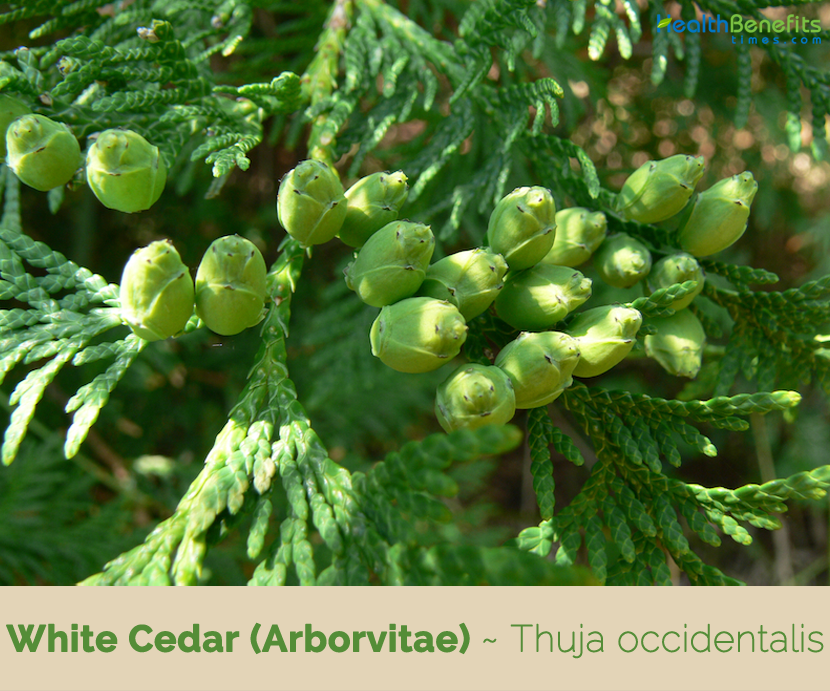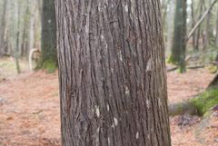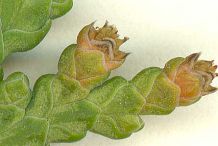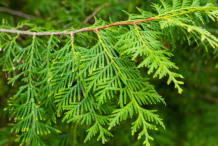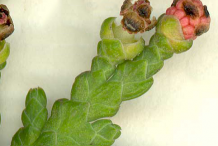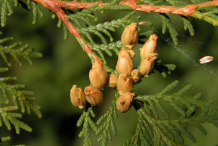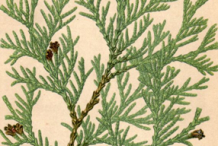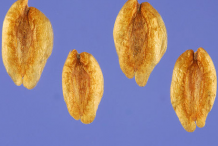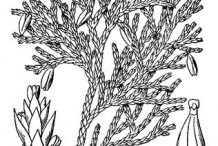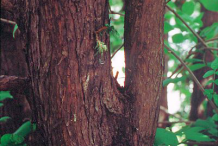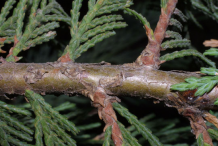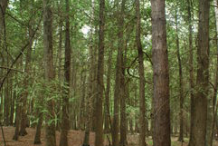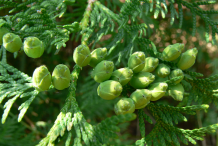The plant was first recognized as a remedy by native Indians in Canada during a 16th century voyage and was found to prove effective in the treatment of weakness from scurvy. In folk medicine, Thuja occ has been used to treat bronchial catarrh, enuresis, cystitis, psoriasis, uterine carcinomas, amenorrhea and rheumatism. Today, it is mainly used in homeopathy as mother tincture or dilution. An essential oil is extracted by steam distillation from the leaves, branches, and bark. Oil is colorless or bright-yellow and has a crisp, camphor-like scent. The oil consists of high levels of the substance thujone which is very toxic.
Plant Description
White Cedar (Arborvitae) is a dense, conical to narrow-pyramidal, often single-trunked, evergreen coniferous tree that grows about 10–20 meters (33–66 ft.) tall with a 0.4 meters (1.3 ft.) trunk diameter, exceptionally to 30 meters (98 ft.) tall and 1.6 meters (5.2 ft.) diameter. The tree is often stunted or prostrate. Bark is gray to reddish-brown, 6-9 mm thick, fibrous, separated into flat, connected ridges and peels in narrow, longitudinal strips. Branchlets are flattened, dark green on the upper side and light-green or brownish on the base but without whitish markings. They all lie on the same plane, lateral sprouts of the last order with reference to the mother axis apical branching mostly to one side.
Leaves
Leaves are differentiable into surface and marginal leaves. The visible leaf parts on the upper side of the branchlets are weakly convex; the underside of the branchlets is weakly concave. Surface leaves are characterized by a broad keel, greatly narrowing toward the tip. The tip is blunt to sharply pointed and slanted toward the sprout. Marginal leaves scaffold mostly pressed against the flanks of the surface leaves or the keels of the next higher marginal leaves. The marginal leaf margins are usually not in contact with the overlying surface leaf. They only run parallel to it for a short distance. Surface leaf tips extend beyond or just as far as the marginal leaf tips.
Flower
Male and female flowers are found in separate cones that are so small as to frequently go unnoticed. After anthesis (the act of dispersing pollen) the male cones quickly wither. The flowering female cones persist and eventually develop a few woody scales oppositely arranged and containing seeds in their axils (the acute angle formed by the scale and the central axis of the cone). Flowering begins about mid-April in upland sites in Brown County.
Fruit (Seed Cone)
Flowers are followed by seed cones that are slender, yellow-green, ripening to brown, 10–15 millimeters (0.39–0.59 in) long and 4–5 millimeters (0.16–0.20 in) broad, with 6-8 overlapping scales. They contain about 8 seeds each. Seeds are 4-7 mm long, with lateral wings about as wide as the body.
Varieties/Types
Many exist, selected for their growth habit, height and width, Summer foliage color (a few are gold-tipped), and healthy green Winter foliage color; some of the most common cultivars are listed below:
- Thuja occidentalis ‘Hetz Midget’: It is globed form, to 3′ feet tall by 3 feet wide.
- Thuja occidentalis ‘Nigra’: It is upright columnar form with dark green Winter foliage, to 20 feet tall by 4 feet wide.
- Thuja occidentalis ‘Peabody’: It is a golden-foliaged, broad-pyramidal form, to 10 feet tall by 5 feet wide, best placed in full sun (where it does not burn), with the foliage bronzing in Winter.
- Thuja occidentalis ‘Pyramidalis’: It is a narrow pyramidal form that is very subject to Winter burn, to 15 feet tall by 4 feet wide.
- Thuja occidentalis ‘Rheingold’: It is an unusual copper-orange to yellow-brown foliage year-round, with a distinctly different awl-type of foliage resembling a dwarf Juniper, globed in shape and slowly growing to 5 feet tall by 4 feet wide.
- Thuja occidentalis ‘Smaragd’ (also known as ‘Emerald’ or ‘Emerald Green’): It is a rapidly becoming the most popular cultivar, a relatively new introduction having emerald green foliage that retains its vibrant green color throughout the Winter, with very dense foliage held in somewhat short vertical scalloped sprays, narrowly pyramidal to columnar in growth habit, to 12 feet tall by 3 feet wide.
- Thuja occidentalis ‘Techny’ (also known as ‘Mission’): It is the long-standing traditional cultivar that has dark green foliage year-round, to 12 feet tall by 4 feet wide, broadly pyramidal or upright oval in shape.
Health benefits of White Cedar (Arborvitae)
Listed below are few of the popular health benefits of using White Cedar (Arborvitae)
1. Skin Conditions
White Cedar (Arborvitae) is best known for its ability to treat skin symptoms which include warts, oily skin, dry skin, sensitive or itchy eruptions, nail fungus and hemorrhoids.
The type of warts that White Cedar (Arborvitae) is beneficial for the type that can be very large and known as “cauliflower warts”. White Cedar (Arborvitae) works to help the body rid itself of the scaly patches that appear, as well as the itchy skin and even brown “age spots” that people tend to complain of.
2. Menstrual Problems
White Cedar (Arborvitae) may work as a homeopathic remedy for a number of menstrual problems. When the menstrual periods are scant or too early, or when there is extreme pain over the left ovary specifically, then this is when White Cedar (Arborvitae) is recommended.
3. Urogenital Problems
Though it is common, it may be hard to detect at first. Urethra is swollen and inflamed with this type of condition, and the urine stream is weak and seems almost split. There is a frequent urge to urinate and infection is prevalent when either a man or a woman suffers from this type of problem. As gonorrhea may be an associated condition, White Cedar (Arborvitae) may be given to help with that problem as well.
4. Headaches
Not only is the type of headache that White Cedar (Arborvitae) may help rather specific, but so too is the type of pain that is suffered. This is a headache that is often caused by stress, exhaustion, or even over excitement. The pain is piercing and is most likely related to infected sinus or even tooth problems.
5. Catarrh and Sinusitis
Individuals who tend to suffer from chronic respiratory or sinus problems may turn to White Cedar (Arborvitae). The catarrh can be foul smelling and is often green or yellow. There is commonly bloody mucus or nasal polyps associated with this type of condition.
Traditional uses and benefits of White Cedar (Arborvitae)
- Cedar leaf oil is distilled from branches and used in medicines and perfumes.
- Tea made from twigs helps to relieve constipation and headache.
- It was commonly used externally as tincture or ointment for the treatment of warts, ringworm and thrush.
- An injection of the tincture into venereal warts is said to cause them to disappear.
- American arbor-vitae was much used by many native North American Indian tribes as a medicine to treat fevers, coughs, headaches, swollen hands and rheumatic problems.
- Plant is most commonly used in modern herbalism to treat warts and polyps, being recommended both internally and externally for these conditions.
- Recently dried leafy young twigs are alterative, anthelmintic, anti-inflammatory, antiseptic, aromatic, astringent, diaphoretic, diuretic and emenagogue.
- Plant is being used internally in the treatment of cancer, especially cancer of the uterus.
- Tea made from the leaves is used in the treatment for bronchitis and other respiratory problems, colds, headaches and as a cough syrup.
- Plants diuretic properties make it useful in treating acute cystitis and bed-wetting in children.
- Leaves are used in steam baths in the treatment of rheumatism, arthritis, colds etc.
- Externally, the leaves are used as a wash for swollen feet and burns.
- Extracts of the leaves can be painted on painful joints or muscles as a counter irritant, improving local blood supply and thus facilitating the removal of toxins, easing pain and stiffness.
- Tincture of the leaves has been used in the treatment of warts, piles, bed sores and fungal infections.
- Oil of white cedar, obtained from the leaves, is an essential oil that is antiseptic, expectorant and rubefacient.
- It is used internally to promote menstruation and relieve rheumatism.
- Oil also stimulates the heart and causes convulsions in high doses.
- Tea of the inner bark is used to promote menstruation and in the treatment of consumption and coughs.
- Homeopathic remedy is made from the leaves and twigs, gathered when the tree is flowering.
- It is used in the household as a treatment against warts, but also has a range of other applications that should only be prescribed by a competent homeopath.
- It treats and lightens old scars and acne.
- It also treats hair falling from eyebrows, scalp and pubic hair.
- Smelly sweat on feet, armpits and groin can be treated with White Cedar.
- It is used to treat eruptions and growth, warts and tumor of all types, particularly face.
- It also treats fungal infections as Mycosis and Candida.
- It is mainly useful in treating upper respiratory illness, such as the common cold, sinusitis, tonsillitis, bronchitis, pneumonia or strep throat.
- It is used topically to relieve arthritis and reduce pain from sore muscles or recovering injuries.
- It is popular as a treatment for parasites and as an insect repellent.
- Various parts of this tree have been taken to induce abortions in the past, but it is no longer recommended for this purpose.
Herbal Preparations
Eastern white cedar tea
Infusion
- Drink 1/4 cup, or use externally as an astringent
- Skin wash.
Eastern white cedar tincture
- 1 part fresh leaves, chopped
- 2 parts menstruum (50 percent alcohol, 50 percent distilled water)
- Take 10–15 drops as needed.
Eastern white cedar–infused oil
- 1 part fresh leaves, chopped
- 2 parts oil
- Use for massage.
Culinary Uses
- Pith of young shoots is cooked and can be added to soups.
- Inner bark is only used in times of emergency or scarcity.
- Inner bark can be dried and ground into a powder, then used with wheat or other cereals in making bread, biscuits etc.
- Leafy branchlets are used as a tea substitute.
- Ojibwa Indians are said to have made soup from the inner bark of the young twigs.
Other facts
- It is often used for hedges and other types of border or shelter plantings.
- White-cedar is used for rustic fencing and posts; other important products include cabin logs, lumber, poles, and shingles.
- Smaller amounts are used for paneling, piling, lagging, pails, potato barrels, tubs, ties, boats (especially canoes), tanks, novelties, and wooden ware.
- The timbers were used to make the ribs in birch bark canoes.
- Boughs are also used in floral arrangements.
- Essential oil of northern white cedar is used in cleansers, disinfectants, hair preparations, insecticides, liniment, room sprays, and soft soaps.
- Twigs are used by some to make teas for relief of constipation and headache.
- Largest known specimen is 34 m tall and 175 cm diameter, on South Manitou Island within Leelanau County, Michigan.
- Fresh branches are used as besoms.
- Leaves have been kept in the clothes cupboard as a perfume, incense and insect repellent.
- Leaves and stems have been used as an incense.
- An essential oil is obtained from the leaves and branches; it is used in perfumery and in medicines.
- Tough and stringy bark has been used to weave fiber bags.
- Powdered leaves are reported to kill flies in 2 hours, the vaporized leaf powder to kill ticks.
Precautions
- Due to the presence of the neuro-toxic compound thujone, internal use can be harmful if used for prolonged periods or while pregnant as it may cause a miscarriage or other complications.
- An essential oil from the leaves is poisonous if taken in large doses.
- Excessive use may cause queasiness, Nausea, vomiting, diarrhea, asthma, flatulence, indigestion and seizures.
- Avoid in case of excess phlegm disorders and loose stools.
- It has been known to cause low blood pressure and seizures.
References:
https://www.itis.gov/servlet/SingleRpt/SingleRpt?search_topic=TSN&search_value=505490#null
https://davesgarden.com/guides/pf/go/83304/
https://npgsweb.ars-grin.gov/gringlobal/taxonomydetail.aspx?id=36584
https://pfaf.org/user/Plant.aspx?LatinName=Thuja+occidentalis
http://www.missouribotanicalgarden.org/PlantFinder/PlantFinderDetails.aspx?kempercode=c246#AllImages
https://botanical.com/botanical/mgmh/c/cedyel41.html
https://plants.usda.gov/core/profile?symbol=thoc2
http://www.theplantlist.org/tpl1.1/record/kew-2432938
https://en.wikipedia.org/wiki/Thuja_occidentalis
https://hort.purdue.edu/newcrop/duke_energy/Thuja_occidentalis.html
Comments
| White Cedar (Arborvitae) Quick Facts | |
|---|---|
| Name: | White Cedar (Arborvitae) |
| Scientific Name: | Thuja occidentalis |
| Origin | Manitoba east throughout the Great Lakes region and into Québec, Vermont, New Hampshire, Maine, Prince Edward Island, New Brunswick, and Nova Scotia |
| Colors | Green when young maturing to brown |
| Shapes | Small green to chartreuse clustered cones of about 1/3 inch long |
| Taste | Bitter, sweet resembling camphor and terebinth |
| Health benefits | Beneficial for Catarrh and Sinusitis, Headaches, Urogenital Problems, Menstrual Problems and Skin Conditions |
| Name | White Cedar (Arborvitae) |
|---|---|
| Scientific Name | Thuja occidentalis |
| Native | Manitoba east throughout the Great Lakes region and into Québec, Vermont, New Hampshire, Maine, Prince Edward Island, New Brunswick, and Nova Scotia |
| Common Names | White cedar, northern white cedar, yellow cedar, Atlantic white cedar, eastern white cedar, swamp cedar, false white cedar, northern white cedar, arborvitae, American arborvitae, eastern arborvitae, Tree of life, Eastern white cedar, Siberian Arborvitae |
| Name in Other Languages | Chinese: Mei guo ya bai(美国崖柏), jin zhong bai(金鐘柏), Xiāng bǎi (香柏), Huáng xīn bǎimù (黄心柏木) Czech: Túje západní, Zerav západní Dutch: Westerse levensboom English: American arbor-vitae, Arbor-vitae, Eastern arbor-vitae, Eastern white-cedar, Northern white-cedar, Swamp Cedar, Tree of life, White-cedar, Arborvitae, Eastern arborvitae, Eastern white cedar, Northern white cedar, Swamp-cedar, Siberian Arborvitae, Finnish: Kanadantuija French: Arbre de vie, Cèdre blanc, Cèdre de l’Est, Cèdre-thuya occidental, Thuier cèdre, Thuya du Canada, Thuya occidental, Balai, Cèdre German: Abendländischer Lebensbaum, Amerikanischer Lebensbaum, Gemeiner Lebensbau, Lebensbaum Hungarian: Nyugati tuja, Nyugati életfa Italian: Albero della vita, Tuia del Canada, Tuia occidentale, Thuja Korean: Seoyangcheugbaeg Ojibwa: Giizhikaatig Polish: Zywotnik Portuguese: Cedro-branco, Tuia-vulgar, Árvore-da-vida, Russian: Туа западная (tuya zapadnaya) Slovak: Tuja západná Spanish: Arbol de la vida, Thuja Swedish: Tuja Ukrainian: Tuya amerikanskaya (Туа американская) |
| Plant Growth Habit | Medium sized, monoecious, evergreen coniferous tree |
| Growing Climates | Habitats consist of forested fens, seeps, springs, forested bogs, along rocky cliffs |
| Soil | Often growing abundantly on soils over limestone in upland areas and on alluvial soils with a high organic and mineral content in lowlands |
| Plant Size | 10–20 meters (33–66 ft.) tall with a 0.4 meters (1.3 ft.) trunk diameter, exceptionally to 30 meters (98 ft.) tall and 1.6 meters (5.2 ft.) diameter |
| Bark | Gray to reddish-brown, 6-9 mm thick, fibrous, separated into flat, connected ridges and peels in narrow, longitudinal strips |
| Leaf | Evergreen, scale-like and abruptly pointed, 2 mm long, opposite in alternating pairs (in 4 rows), bright green above and pale green below, sometimes becoming yellow-brown in winter, with a spicy fragrance when crushed. |
| Flowering Season | April to May |
| Flower | Male and female flowers are found in separate cones that are so small as to frequently go unnoticed |
| Fruit Shape & Size | Small green to chartreuse clustered cones of about 1/3 inch long often go unnoticed in Summer |
| Fruit Color | Green when young maturing to brown |
| Flavor/aroma | Pungent and balsamic |
| Taste | Bitter, sweet resembling camphor and terebinth |
| Propagation | By rooted stem cuttings |
| Plant Parts Used | Young branches, twigs, bark, leaves, stems, seeds |
| Season | September to October |
| Lifespan | Can live 400-800 years under favorable conditions |
| Varieties/Types |
|
| Health Benefits |
|


